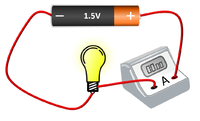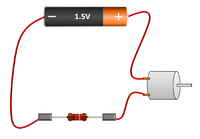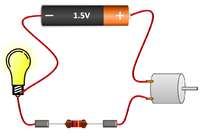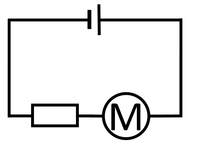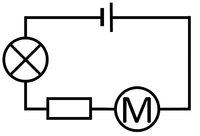Difference between revisions of "Series Circuit"
(→Key Stage 4) |
|||
| Line 15: | Line 15: | ||
|- | |- | ||
| style="height:20px; width:200px; text-align:center;" |The [[Electrical Bulb|bulb]] and [[Ammeter]] are in [[Series Circuit|series]] so they have the same [[Electrical Current|Current]] going through them. | | style="height:20px; width:200px; text-align:center;" |The [[Electrical Bulb|bulb]] and [[Ammeter]] are in [[Series Circuit|series]] so they have the same [[Electrical Current|Current]] going through them. | ||
| − | | style="height:20px; width:200px; text-align:center;" |The [[motor]] and [[resistor]] are in [[Series Circuit|series]] so they have the same [[Electrical Current|Current]] passing through them but share the 1. | + | | style="height:20px; width:200px; text-align:center;" |The [[motor]] and [[resistor]] are in [[Series Circuit|series]] so they have the same [[Electrical Current|Current]] passing through them but share the 1.5V [[Potential Difference|potential difference]] between them. |
| − | | style="height:20px; width:200px; text-align:center;" |The [[motor]], [[resistor]] and [[Electrical Bulb|bulb]] are in [[Series Circuit|series]] so they all have the same [[Electrical Current|Current]] passing through them but share the 1. | + | | style="height:20px; width:200px; text-align:center;" |The [[motor]], [[resistor]] and [[Electrical Bulb|bulb]] are in [[Series Circuit|series]] so they all have the same [[Electrical Current|Current]] passing through them but share the 1.5V [[Potential Difference|potential difference]] between them. |
|} | |} | ||
Revision as of 17:39, 6 April 2019
Contents
Key Stage 3
Meaning
A Series Circuit is an electrical circuit with only one path for the current to flow.
About Series Circuits
- In a series circuit the current is the same at all locations.
- Components placed in series share the potential difference supplied by the power supply.
Examples
| The bulb and Ammeter are in series so they have the same Current going through them. | The motor and resistor are in series so they have the same Current passing through them but share the 1.5V potential difference between them. | The motor, resistor and bulb are in series so they all have the same Current passing through them but share the 1.5V potential difference between them. |
Key Stage 4
Meaning
A Series Circuit is an electrical circuit with only one path for the current to flow.
About Series Circuits
- In a series circuit the current is the same at all locations.
- Components placed in series share the potential difference supplied by the power supply.
Examples
| The bulb and Ammeter are in series so they have the same Current going through them. | The motor and resistor are in series so they have the same Current passing through them but share the potential difference between them. | The motor, resistor and bulb are in series so they all have the same Current passing through them but share the potential difference between them. |
Resistors in Series
- Adding resistors in series increases the resistance in the circuit.
- The resistance of each resistor can be added together.
| The resistance between points A and B is:
5Ω. | |
| The resistance between points A and B is:
2Ω + 5Ω = 7Ω | |
| The resistance between points A and B is:
2Ω + 5Ω + 9Ω = 16Ω |
